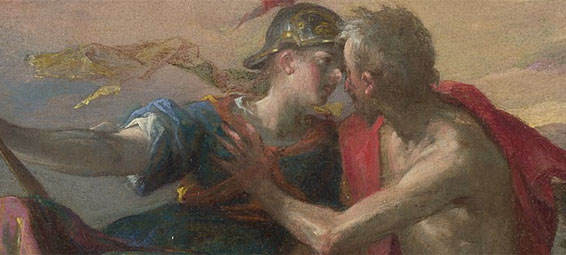Last week, Google launched its Art Project, an online application that allows anyone anywhere to step into 17 of the world’s greatest museums – virtually – viewing some works with insanely high resolution, and other works via something akin to street view. It seems that Google has, yet again, creating something poised to revolutionize the way we think about a certain aspect of our experience. Now, the reactions to the project are trickling in.
From Roberta Smith in the New York Times:
This feels like an eerie approximation, at a clinical, digital remove, of the kind of intimacy usually granted only to the artist and his assistants, or conservators and preparators.
Still, the most unusual aspects of the experience are time, quiet and stasis: you can look from a seated position in the comfort of your own home or office cubicle, for as long as you want, without being jostled or blocked by other art lovers.
And while the Internet makes so much in our world more immediate, it is still surprising to see what it can accomplish with the subtle physicality of painting, whether it is the nervous, fractured, tilting brush strokes of Cezanne’s “Château Noir” from 1903-4, at the Museum of Modern Art, or the tiny pelletlike dots that make up most of Chris Ofili’s “No Woman No Cry” from about a century later at the Tate Modern in London (the only postwar work among the 17 mega-pixel stars).
And a more skeptical Will Brand on Art Fag City:
As a way of viewing art, Art Project has definite downsides. The pieces that work best when viewed in this context are the iconic pieces, the pieces we’ve seen thousands of times before as JPEGs; what I see in the top image is Starry Night and Sleeping Gypsy, rather than anything to do with paint or canvas or technique or presence. That’s not a new problem, of course – people have been complaining about it as long as the Mona Lisa has adorned coffee mugs. Rather the issue here is that there’s no possibility of noticing anything else, no possibility of the redemption of the flâneur: it is difficult for me to notice a work which has not been intended for me to notice it, having now passed through a fourth filter of virtual reality that obscures what little survived the filters of criticism, curation, and history.
The Economist likes the project, but regrets it isn’t comprehensive enough:
It is a fine thing to be able to study a Rembrandt while in your underwear, squinting up close or pulling away, and taking note of what’s next to it. . . . So far most of the museums involved in the project are in Europe, Washington, DC and New York. The art skews towards old masters, and there is little contemporary or non-Western thus far. Users don’t quite get to feel the way the paintings in a museum interact with each other, the hushed, echoey steps of other people or the sanctified feeling of calm. Looking through the Google Art Project is a bit like walking by a bakery, smelling the brownies and shoving your nose against the glass. It intensifies the hunger rather than quashing it.
And the Guardian’s Tim Adams wonders if the project will ever be a substitute for the real thing, though, you can guess what his answer will be:
After spending a few hours on the site (yet another new way of digressing on a screen), the answer to the first part feels like a qualified no. Looking at a painting on screen, however vivid the detail, is wholly different in kind from standing in front of it. Though there is genuine wonder in the backlit clarity of the images – in Bellini’s St Francis in the Desert from the Frick Collection in New York, for example, you can make out the artist’s fingerprints in the surface of the paint – as with any reproduction, what is lost is a sense of the painting as a physical object, as a little framed force field.
And while we might guess that critics will be quick to point to the project’s shortcommings, during a conversation I had with the director of London’s Tate Museum, Sir Nicholas Serota, who was in town last week, Serota said the most revolutionary aspect of the project may be its use in arts education. In fact, the project (and the Tate is a participating museum) may dovetail into some of the British museum’s educational intitiatives which, as described by Serota, will expand the reach of the museum internationally by leveraging virtual technology.
Image: Hans van Aachen The Amazement of the Gods (detail) via The Google Art Project.





